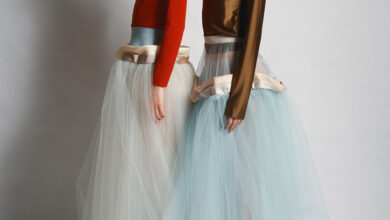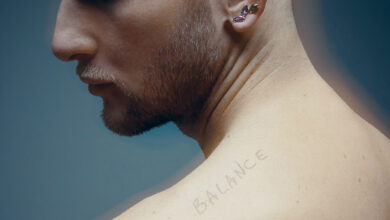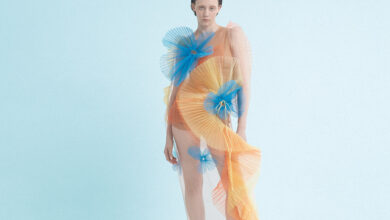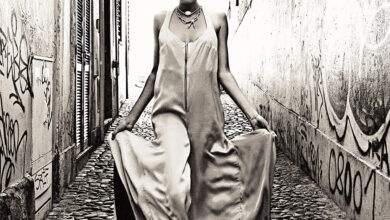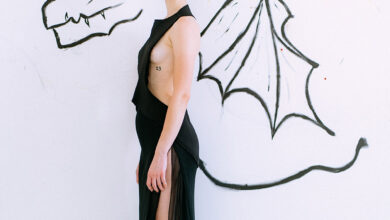DesignFashionZoot lovesZZ
CHAPEAU TO STEPHEN JONES
Milliner extraordinaire Stephen Jones talks to Zoot Magazine about the joys and challenges in his career and of that Simonetta picture that first inspired him to become a hat designer. The images, featuring his haute couture pieces, were shot exclusively for Zoot by renowned photographer, Peter Ashworth.
Interview by Anna Battista, 2011
Nothing marks a period or a fashion more than little yet striking details and finishing touches like hats. A status symbol with a practical and protective function, a hat can also awake admiration and interest and be used as a weapon to heighten, enhance, reveal or hide any aspect of one’s personality. Milliner extraordinaire Stephen Jones knows this very well.

Chic and charming, usually wearing one of his quirky creations perched on his head, since opening his first hat salon in London’s Covent Garden in 1980, Jones’s unique creations appeared in films and even on a British postage stamp and he designed hats for pop stars (hands up who remembers a young Stephen Jones donning a fez in Culture Club’s first video, “Do You Really Want to Hurt Me?”), celebrities and royalty.
Throughout his career, spanning three decades, he collaborated with many designers – among them Zandra Rhodes, Claude Montana, Jean-Paul Gaultier, Thierry Mugler, Comme des Garçons, Giles Deacon, Marc Jacobs, Vivienne Westwood and John Galliano – creating iconic pieces like the ones we admired last week on the Christian Dior Haute Couture runway. Thanks to Jones’s talent and imagination, new generations have rediscovered hats’ grace, harmony and utility and a tradition preserved in the precious hands of very few rare milliners.

Zoot Magazine: In 2010 your house celebrated its 30th anniversary: what has changed since you first started working as a milliner?
Stephen Jones: You could argue that everything has changed since I first opened my hat salon. We use very different technology compared to those times and we communicate in different ways. But also fashion has dramatically changed: when I first started, fashion was not something that everybody was interested in, it was in the ‘80s that it started being communicated as a mass phenomenon.
Zoot Magazine: There are hat designers who dislike being called ‘milliners’ as this term first referred to the Milanese tailors who moved in the 1600s to London: do you like being referred as a milliner?
Stephen Jones: Yes, I do actually. Everybody uses the word ‘designer’, but ‘milliner’ sounds more unusual!
Zoot Magazine: As a student you were fascinated by a picture taken by Norman Parkinson for US Vogue in 1952 that portrays Italian designer Simonetta proudly overlooking the skyscrapers of New York from a window of the Plaza Hotel, wearing a short and ample jacket in red faille and taffeta matador trousers. In 2004 you also dedicated to her some pieces from your Autumn/Winter collection, “La Prima Donna”. What fascinated you about Simonetta and do you think your career would have been different if you hadn’t seen that picture?
Stephen Jones: Probably yes, I would have had a different career. I remember seeing that picture in 1976 while leafing through the book In Vogue by Brigid Keenan. Interestingly enough, in some ways, Simonetta’s attitude was almost punk. Punk had a real arrogance about it and a really strong point of view, this is why Simonetta looked like a punk to me. At that time fashion was really about basic or country clothes such as Calvin Klein or Ralph Lauren’s designs, but Simonetta looked really strong in that attire and in that colour palette – black and red – two punk colours as well.

Zoot Magazine: John Galliano’s recent Haute Couture collection for Dior was inspired by René Gruau’s illustrations: has the work of this iconic artist ever inspired you in your creations for Dior?
Stephen Jones: Yes, it actually did. René Gruau is an incredible artist and I’ve always found him the most extraordinary illustrator, he is indeed my favourite illustrator. He was with Dior before it became such a famous fashion house and in many ways this represents a strong connection with my own work since my designs for Dior and John Galliano are probably the most important pieces I have done in my career.
Zoot Magazine: What’s the first thing you do when a designer comes to you and asks for hats or head pieces for his or her collection? Do you chat with them to understand their personality or do you have a sixth sense and already know what they like?
Stephen Jones: When I’m doing a collection for a designer, the first thing you have to keep is an open mind, so you don’t have to come with any pre-conceptions at all. When you’re working with somebody on a regular basis it’s even more important to have a fresh approach every season. Yet working with every different designer has a different approach. For example, if I’m working with John Galliano he will say ‘This is the theme of the season, this is what we are interested in and what we are researching at the moment’. If I’m working with Rei Kawakubo she almost doesn’t give me any brief at all, but asks me to use my invention, my imagination and my creativity. Sometimes she will send me a photograph, telling me ‘I would like to have something along these lines, please make your interpretations’, but it changes with people, there is not an established form for that.
Zoot Magazine: Have you ever been moved by the reactions to your designs?
Stephen Jones: Yes, I have been but, at the same time, fashion is an ongoing process and you must get on. If I’m showing a designer a hat two days before the show, I always have to get on to the next hat and show them how it’s going to look on the runway. Being moved may be part of the whole process, but the latter involves a lot of other aspects.
Zoot Magazine: Do you think the meaning of wearing a hat has changed in our days?
Stephen Jones: Absolutely. Hats do different things. Of course you can wear a hat to keep you warm on a Monday morning, and you can do it now or you could have done it thirty or forty years ago. Similarly, you can wear a hat to be very well dressed, if you’re going to a formal occasion for example. But if you’re wearing a hat to go to a nightclub, that’s something different. I remember in the ‘80s men didn’t really wear hats so much, but now they do and that’s stylish, but it also shows they are taking an interest in their looks.
Zoot Magazine: What’s the most challenging aspect of your job?
Stephen Jones: Running any business is not easy, but in my case I think the challenge stands in always coming up with new designs. Even though I always have a lot of ideas, trying to stick to the right ones always proves difficult.

Zoot Magazine: Apart from hats, do you design also other accessories?
Stephen Jones: I have an accessory line selling exclusively in Japan and I’ve been working on a licence collection for Galliano that is manufactured in Italy and includes Galliano’s hats for men and women, and scarves.
Zoot Magazine: When do you usually start working on the pieces for the Spring/Summer catwalk shows?
Stephen Jones: My collaborations with other designers start with the men and Haute Couture’s shows in January. I mainly do Comme des Garçons menswear and sometimes also collaborate with other designers such as Walter Van Beirendonck. For what regards the Spring/Summer collections, usually people contact me in the middle of December for the February and March fashion weeks when they suddenly think ‘Oh Hats!’ and then they call me asking if they can meet me in early January. But, since I’m usually away at that time working on men and Haute Couture’s catwalks, we end up organising what we need for the Spring/Summer shows very quickly!

Zoot Magazine: Who would be the best model for your hats?
Stephen Jones: Though it’s difficult to mention just one person, if I had to choose somebody contemporary, I would say Dita Von Teese, because she could wear something extremely simple and make it look just fabulous!
Zoot Magazine: What’s the most important lesson you learnt from life?
Stephen Jones: You have to really enjoy what you do because at 3 o’clock in the morning when something is not working out you have to still love it, you can not resent it. What else have I learnt from life? Don’t examine things too much, just get on and do them!

Zoot Magazine: What plans do you have for 2011?
Stephen Jones: “Hats: An Anthology”, the Victoria & Albert Museum exhibition, will go on tour, moving to New York in August/September 2011, and “Stephen Jones & The Accent of Fashion” has recently featured at Antwerp’s Mode Museum (MoMu). The latter will hopefully go to Shanghai, Tokyo, Moscow and Istanbul. I think this is great because it will allow me to introduce people to an extraordinary world not many know about – the world of hats.
Styling Assistance Irene Manicone and Akpomena Rana

